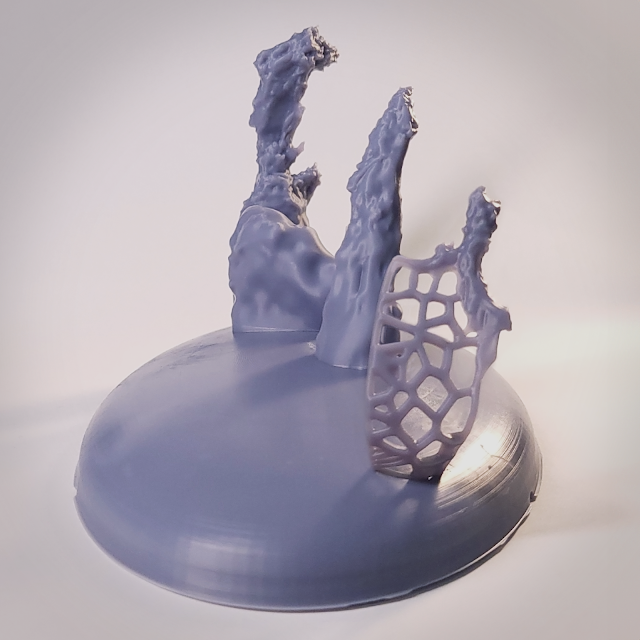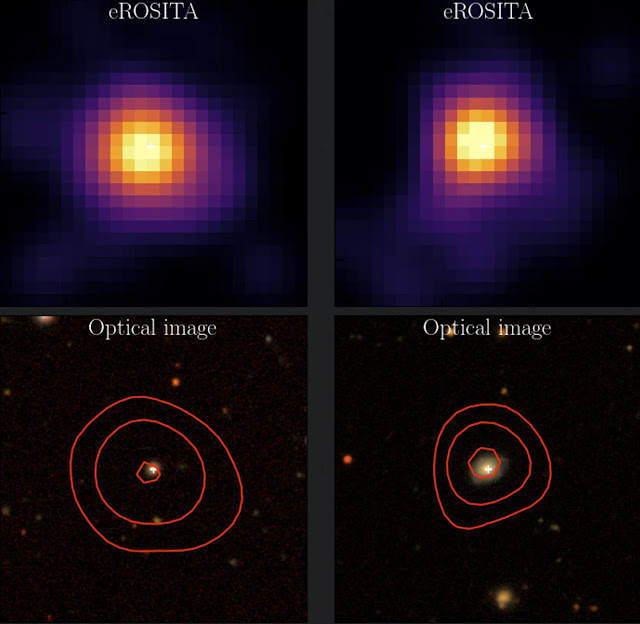
Artist's conception of an early quasar. The black hole in the center is surrounded by a bright accretion disk. Farther outside is the "dust torus", an irregular, larger and markedly thicker disk that can obscure an outside observer's view of the accretion disk. The dust torus predominantly emits mid-infrared light, and its properties can be read off the overall shape ("continuum") of the spectrum. The accretion disk's magnetic fields produce a focused high-energy jet of particles that emitted from the immediate neighbourhood of the black hole, beaming away at right angles to the disk. Above and below the disk are irregular gas clouds. Since their shapes are not known, they are shown here in stylized form, as spheres. The gas clouds that are close to the center orbit the black hole at high speeds. This produces broad emission lines in the quasar's spectrum, and that region of gas is called the "broad-line region". The gas clouds farther away, shown here as somewhat larger sphere, move less quickly, producing narrower emission lines; they form what is called the "narrow-line region".© T. Müller / MPIA
Using the space telescope JWST, astronomers have examined one of the most distant known black holes in the universe. Their observations provide a glimpse of the growth of black holes in the early universe, less than a billion years after the Big Bang. Surprisingly, the early black hole in question seems to be “feeding” in much the same manner as its more recent kin. Astronomers have been struggling for a while now to explain how the earliest black holes gained their considerable masses. The new results all but rule out unusually efficient feeding mechanisms at early times as a possible solution. The results have been published in the journal Nature Astronomy.
The first billion years of cosmic history
pose a challenge: The earliest known black holes in the centers of
galaxies have surprisingly large masses. How did they get so massive, so
quickly? The new observations described here provide strong evidence
against some proposed explanations, notably against an “ultra-effective
feeding mode” for the earliest black holes.
The limits of supermassive black hole growth
Stars and galaxies have changed
enormously over the past 13.8 billion years, the lifetime of the
Universe. Galaxies have grown larger and acquired more mass, either by
consuming surrounding gas or (occasionally) by merging with each other.
For a long time, astronomers assumed that the supermassive black holes
in the centers of galaxies would have grown gradually along with the
galaxies themselves.
But black hole growth cannot be arbitrarily fast. Matter falling onto a black hole
forms a swirling, hot, bright "accretion disk." When this happens around
a supermassive black hole, the result is an active galactic nucleus.
The brightest such objects, known as quasars, are among the brightest
astronomical objects in the whole cosmos. But that brightness limits how
much matter can fall onto the black hole: Light exerts a pressure,
which can keep additional matter from falling in.
How did black holes get so massive, so fast?
That is why astronomers were surprised when, over the past twenty years,
observations of distant quasars revealed very young black holes that had
nevertheless reached masses as high as 10 billion solar masses. Light
takes time to travel from a distant object to us, so looking at far-away
objects means looking into the distant past. We see the most distant
known quasars as they were in an era known as “cosmic dawn,” less than
one billion years after the Big Bang, when the first stars and galaxies
formed.
Explaining those early, massive
black holes is a considerable challenge for current models of galaxy
evolution. Could it be that early black holes were much more efficient
at accreting gas than their modern counterparts? Or could the presence
of dust affect quasar mass estimates in a way that made researchers
overestimate early black hole masses? There are numerous proposed
explanations at this time, but none that is widely accepted.
A closer look at early black-hole growth
Deciding which – if any – of the explanations are correct requires a more
complete picture of quasars than had been available before. With the
advent of the space telescope JWST, specifically the telescope’s
mid-infrared instrument MIRI, astronomers' ability to study distant
quasars took a gigantic leap. For measuring distant quasar spectra, MIRI
is 4000 more times more sensitive than any previous instrument.
Instruments like MIRI are built by international consortia, with scientists,
engineers and technicians working closely together. Naturally, a
consortium is very interested in testing whether their instrument
performs as well as planned. In return for building the instrument,
consortia typically are given a certain amount of observation time. In
2019, years before JWST launched, the MIRI European Consortium decided
to use some of this time to observe what was then the most distant known
quasar, an object that goes by the designation J1120+0641.
Observing one of the earliest black holes
Analysing
the observations fell to Dr. Sarah Bosman, a post-doctoral researcher
at the Max Planck Institute for Astronomy (MPIA) and member of the MIRI
European consortium. MPIA’s contributions to the MIRI instrument include
building a number of key internal parts. Bosman was asked to join the
MIRI collaboration specifically to bring in expertise on how to best use
the instrument to study the early Universe, in particular the first
supermassive black holes.
The observations were carried out in January 2023, during JWST’s first cycle
of observations, and lasted for about two and a half hours. They
constitute the first mid-infrared study of a quasar in the period of
cosmic dawn, a mere 770 million years after the Big Bang (redshift z=7).
The information stems not from an image, but from a spectrum: the
rainbow-like decomposition of the object's light into components at
different wavelengths.
Tracing dust and fast-moving gas
The overall shape of the mid-infrared spectrum ("continuum") encodes the
properties of a large torus of dust that surrounds the accretion disk in
typical quasars. This torus helps to guide matter onto the accretion
disk, "feeding" the black hole. The bad news for those whose preferred
solution to the massive early black holes lies in alternative quick
modes of growth: The torus, and by extension the feeding mechanism in
this very early quasar, appear to be the same as for its more modern
counterparts. The only difference is one that no model of quick early
quasar growth predicted: a somewhat higher dust temperature around a
hundred Kelvin warmer than the 1300 K found for the hottest dust in less
distant quasars.
The shorter-wavelength part of the spectrum, dominated by the emissions from the accretion disk
itself, shows that for us as distant observers, the quasar's light is
not dimmed by more-than-usual dust. Arguments that maybe we are merely
overestimating early black hole masses because of additional dust are
not the solution either.
Early quasars “shockingly normal”
The quasar's broad-line region, where clumps of gas orbit the black hole at
speeds near the speed of light – which permit deductions about the
black hole mass, and the density and ionization of the surrounding
matter – look normal as well. By almost all the properties that can be
deduced from the spectrum, J1120+0641 is no different from quasars at
later times.
“Overall, the new observations only add to the mystery: Early quasars were shockingly
normal. No matter in which wavelengths we observe them, quasars are
nearly identical at all epochs of the Universe,” says Bosman. Not only
the supermassive black holes themselves, but also their feeding
mechanisms were apparently already completely "mature" when the Universe
was a mere 5% of its current age. By ruling out a number of alternative
solutions, the results strongly support the idea that supermassive
black holes started out with considerable masses from the get-go, in
astronomy lingo: that they are "primordial" or "seeded large."
Supermassive black holes did not form from the remnants of early stars,
then grew massive very fast. They must have formed early with initial
masses of at least a hundred thousand solar masses, presumably via the
collapse of massive early clouds of gas.
Background information
The
results described here have been published as S. Bosman et al., "JWST
rest-frame infrared spectroscopy reveals a mature quasar at cosmic dawn"
in the journal
Nature Astronomy.
The MPIA scientists involved are Sarah Bosman (also University of
Heidelberg), Fabian Walter, Leindert Boogaard, Manuel Gudel and Thomas
Henning, in collaboration with the MIRI Guaranteed Time Observations
(MIRI GTO) team.
You can access the original paper via
press@nature.com or
https://press.nature.com
Contact:
Dr. Sarah Bosman
tel:+49 6221 528-375
bosman@mpia.de
Max Planck Institute for Astronomy, Heidelberg
Dr. Markus Pössel
Head of press relations and outreach
tel:+49 6221 528-261
pr@mpia.de
Max Planck Institute for Astronomy, Heidelberg






















